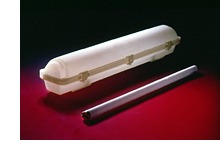|
Zumtobel
 Zumtobel Lightens its Toolmaking Load
Zumtobel Lightens its Toolmaking Load
Stereolithography Powers "Fastest Market Launch" on New Product
When it comes to time-based competition Zumtobel AG has seen the light.
A luminary in the lighting industry, Austria's Zumtobel recently proved
what one SLA 500 can do to redefine toolmaking and tradeshows.
Few companies in the world can say: "Light is our profession." At least, not with the panache of Austria's Zumtobel Licht GmbH, a supernova at parent company Zumtobel Holding AG, a lighting giant. Founded by Dr. Walter Zumtobel in 1950, and currently led by family visionary, Jürg Zumtobel, the company's artful lighting systems illuminate prestigious interiors throughout the modern world, including the Duisburg Business Promotion Centre in Germany, the Waterloo International Terminal in London, and the Levi Strauss Ice House in San Francisco.
Zumtobel Licht fuses design innovation with functionality to create truly exceptional products. One such example is its new line of FZ moisture proof luminaires in which stereolithography (SL) played a guiding role. The Hannover Trade Show, the world's biggest light show, was only 12 months away. Zumtobel was in a winner-take-all race against its competition for the "fastest market launch." But the FZ design was still evolving and several questions remained unanswered such as how to fortify the unit design against dampness and airborne dust.
Wolfgang Humml, manufacturing chief at Zumtobel's Toolmaking Division, and Bruno Kuen, SL specialist, led the push to Hannover. First, an SL model was built in two parts, the housing and diffuser. A vacuum casting mold was made from the SL pre-master, resulting in 10 to 12 quality castings, which were destined for injection molding tools. The vacuum cast parts were then transferred to sales managers at Zumtobel offices throughout Britain, France, Germany, Italy, Spain, and Switzerland to confirm proof-of-concept from the viewpoint of future customers.
Eliminate Tooling Errors
The FZ luminaire styling was not quite acceptable because of "too many
edges." The multiple iterative capability of SL enabled engineers to quickly
redesign a more streamlined shape - all before any commitment to expensive
tooling. New dies for the first mold could have easily cost $145,000 USD
compared to the actual cost of $17,180 USD. Tooling costs for all 12 large
molds via conventional methods could have skyrocketed to $1.7 million
USD and consumed 24,000 man-hours.
"With SL, errors in tools are cut in half - it's an enormous time and
cost penalty to change a steel tool," explains Mr. Humml. In addition,
all the design concerns were resolved at a total project cost of only
$40,000 USD. Zumtobel proved overwhelmingly the inherent strength of SL
as a problem-solving tool. In fact, due to time pressures and logistics,
Mr. Humml believes their sales manager would never have been able to poll
their key accounts in six separate countries without the advantage of
SL. "The result would have been a luminaire our customer would simply
not accept."
Ultimately, Zumtobel cut development time by eight months and became a shining success at Hannover. The marketing team planned to sell 200,000 FZ luminaires in the first year. Instead, they sold 400,000! In the words of Mr. Kuen, "I'm sure our SLA 500 has paid for itself just on this project alone."
|



